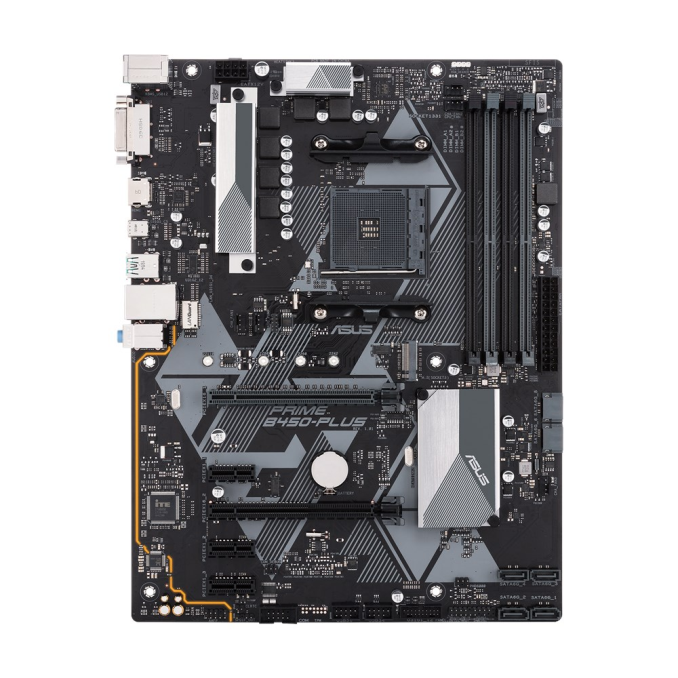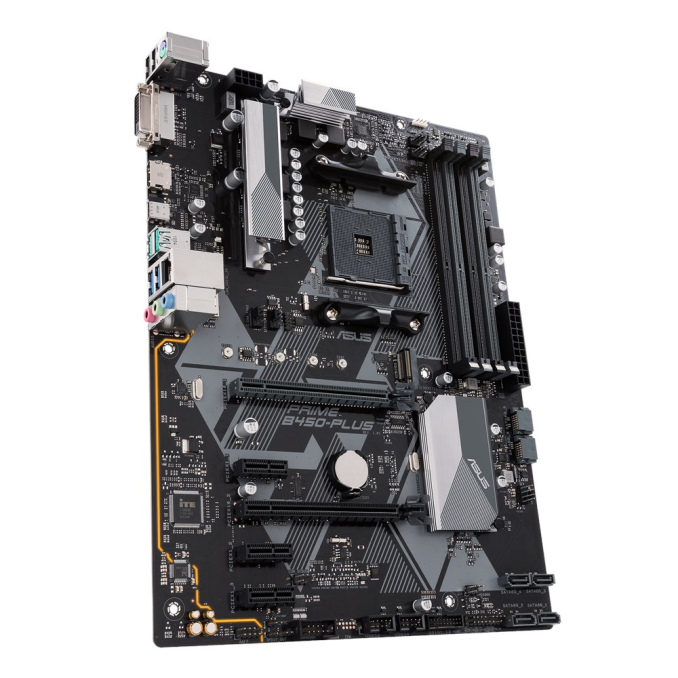Analyzing B450 for AMD Ryzen: A Quick Look at 25+ Motherboards
by Gavin Bonshor on July 31, 2018 8:00 AM ESTASUS Prime B450 Plus
Although the TUF and Prime brands from ASUS share similar pricing schemes with their low-cost entry-level options, the TUF series is aimed specifically for gamers, whereas the Prime range shifts to a more basic and subtle range of features and aesthetics. The ASUS Prime B450-Plus provides a solid infrastructure to build a solid and good value system upon. The main features of the Prime B450-Plus include a Realtek ALC887-VD2 audio codec with an entry to DDR4-3200 memory support at a low base price.
The aesthetics of the Prime B450-Plus ATX motherboard come through a subtle and clean looking black PCB with grey print which resembles a triangle pattern. The heatsinks across the board feature a classic looking light metallic finish, with a contrasting shade of darker grey to give extra definition. While there are no LEDs embedded into the PCB of the motherboard, a single Aura Sync-enabled RGB header is present to allow for users looking to add at least some element of RGB to their system.
In terms of PCIe, the board has two full-length PCIe slots with the top (grey) slot having a PCIe 3.0 x16 interface, and the second slot (black) taking its bandwidth directly from the B450 chipset, giving it an operational specification of PCIe 2.0 x4. In addition, a further three PCIe 2.0 x1 slots are there to give support for adapter cards such as sound cards and additional networking controllers etc.
The board has a total of four memory slots capable of supporting DDR4-3200, with a maximum capacity across the available slots of up to 64 GB. Both non-ECC and ECC memory are supported, with the latter entirely dependent on the used processor's capability to do so.
Providing power to the motherboard on the right-hand side of the board is a 24-pin ATX power input and between the corners of the MOSFET heatsinks is a single 8-pin ATX 12 V power input to provide power to the CPU. ASUS also advertises a 6-phase Digi+ digital power delivery on the B450-Plus Prime motherboard which is standard across their low-mid range (non-ROG branded) B450 chipset models.
Making up the storage is a total of six SATA 6 Gbps ports with four of them featuring straight angled connectors, whereas the remaining two located below the 24-pin ATX motherboard power input is right-angled. As with all of the B450 motherboards at launch, the SATA 6 Gbps ports support RAID 0, 1 and 10 arrays. A single M.2 slot is located just above the top full-length PCIe 3.0 x16 slot and has support for both SATA and PCIe 3.0 x4 M.2 22110 (22 x 110 mm) SSDs.
In relation to cooling options, the Prime B450-Plus has a total of five 4-pin headers with them being split between three different sections; three for case fans, one dedicated to the CPU fan and one for use with an AIO CPU cooling pump. A clear CMOS jumper is located towards the bottom PCIe 2.0 x1 and there’s capability to expand the featured USB connections by a further two USB 3.1 5 Gbps and four additional USB 2.0 ports thanks to internal headers.
The rear panel on the Prime B450-Plus is a variety of connections including two USB 3.1 10 Gbps Type-A ports, two USB 3.1 5 Gbps Type-A ports, two USB 2.0 ports and a single USB 3.1 5 Gbps Type-C port. Also features is three 3.5mm audio jacks with the onboard audio being powered by the Realtek ALC887-VD2 audio codec, and the single LAN port being handled by a Realtek RTL8111H Gigabit networking controller. To make use of the Ryzen 2000 series APUs is an HDMI and DVI-D output, with a single PS/2 keyboard/mouse combo port finishing off the rear I/O.
While the Prime range is a relatively basic and standard foundation to create a new system, the limitations are on the rest of the components and not the motherboard itself. The Prime B450-Plus looks good for a user not looking for anything too fancy, without paying extra for premium controllers such as the Realtek ALC1220 audio codec; the launch pricing of $109.99 signifies the intent to offer decent quality at a low entry price.





_thumb.png)
_thumb.png)
_thumb.png)
_thumb.png)
_thumb.png)
_thumb.png)








62 Comments
View All Comments
Ian Cutress - Tuesday, July 31, 2018 - link
10GbE has nothing to do with StoreMI. I was using it as an example of something that the system supports if you buy it. Like StoreMI.jtd871 - Tuesday, July 31, 2018 - link
It might have been more clear what point you were making if you had replied "The systems also support ...".The way it's presented in the table, though, it appears as if you are saying the older chipsets themselves do not support StoreMI, which is not true.
Death666Angel - Tuesday, July 31, 2018 - link
Seemed perfectly understandable to me. And if you know one thing about StoreMi, you know what the chart refers to. It's just software after all.jtd871 - Tuesday, July 31, 2018 - link
Less-savvy readers might get an incorrect impression and come away with the sense that they need to "buy up" to use StoreMI at all.dante01 - Tuesday, August 7, 2018 - link
Hey guys, whats the best option between the asrock b450 itx and the msi b450i ? The msi seems to be missing one fan header and usb 3.1 gen 2 compared to the asrock but the msi may have better VRMs...It also supports 3000mhz ram. I don't know what to choose, some have said that asrock b450 itx is not good (VRMs wise), i intend to OC my ryzen 2600 so VRMs are importantThanks !
asmian - Tuesday, July 31, 2018 - link
compliment (be nice to) != complement (be a good partner to)"Not much hasn't changed" - strange double negative
If there's no in-house editor, then more careful proofreading before posting, please.
Ian Cutress - Tuesday, July 31, 2018 - link
15000 words with a couple of hours to edit. Always going to be the odd one or two typos.jordanclock - Tuesday, July 31, 2018 - link
then be more careful**FTFY.
msroadkill612 - Tuesday, July 31, 2018 - link
Its still there. Pity. Others may think it is correct.jtd871 - Tuesday, July 31, 2018 - link
Your summary table based on features does not currently list the ASUS mITX board under those with 2 M.2 slots.